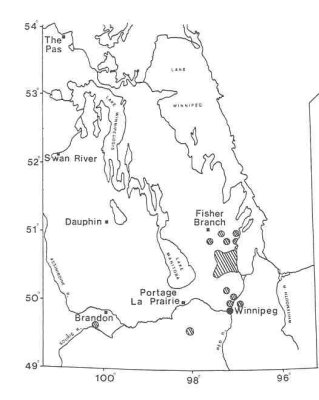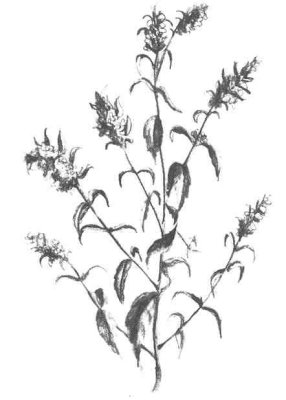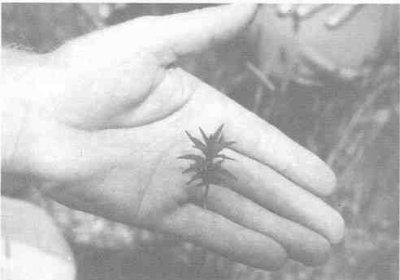How To Control Red Bartsia
Origin and Distribution
Red bartsia (Odontites serotina) is a weed of hayland, pastures and roadsides which appeared in the Interlake region of Manitoba in the 1950s (Figure 2). The weed apparently was introduced into the area in crates which were shipped from West Germany into the Canadian Armed Forces Base at Gimli. The infestation started on the base and spread into surrounding farmland by way of mowed hay from red bartsia infested areas along the edges of runways. Today the main area of infestation (Figure 1) is in the eastern Interlake particularly in the triangle formed by Gimli, Fraserwood and Meleb. New infestations have recently been found in the Souris and Carman areas. Isolated patches have also been found near Stonewall, Selkirk and Winnipeg. |
|
Description and Life CycleRed bartsia germinates in late spring. At first it grows slowly and may not be noticed during early summer (Figure 3).In July, the weed begins rapid growth, reaching heights of 15 to 30 cm (6 to 12 inches). Stems are erect, branching and bear clasping narrow leaves about three cm (1.25 inches) in length. The leaves occur in pairs and taper to a point. Both the leaves and the stem are densely hairy. Spike-like clusters of flowers develop on flower stalks which grow from the point where the leaves join the stem. Most flowers are found on the top half of the stem. The blossoms are reddish-purple in colour and resemble tiny snapdragon flowers (one cm or less than a ½ inch long). At maturity, an infestation gives a reddish tingle to hayfields, pastures or ditches. This reddish tinge is also seen in infestations of red samphire (Salicornia), a plant frequently found growing in ditches and often confused with red bartsia. The two species can be distinguished by the absence of any leaves on red sapphire. Red bartsia is prolific, producing about 1400 seeds per plant. The seed shells out in September, infesting fields for some time to come. Coarse hairs cover the seeds, enabling them to adhere to clothing and equipment. The seed is light and is easily carried along ditches and through fields by runoff water. |
Economic Importance
Red bartsia does not persist under cultivation. For this reason it is seldom a problem in cereals or special crops. The weed is, however, a serious concern in hayland and in pastures. In hay fields, the tiny seedlings grow rapidly after the first cut of hay has been removed. Plants begin flowering two to three weeks later, making the danger of seed contamination in the second cut a serious concern. In pastures, the weed is not grazed by cattle and, with time heavy infestations spread through the field.
Control
Cultivation in combination with growing a competitive crop will limit red bartsia infestations. This may not always be a viable alternative since the weed often infests areas are not suitable for tillage because of stoniness or poor drainage.
The weed is susceptible to either 2,4-D amine or 2,4-D LV ester sprayed at a rate of 0.6 L/acre product (500 g/L formulations). On roadsides and in pastures, spraying should commence as soon as the plants appear. Recheck sprayed areas in mid- to late summer and respray if new seedlings have germinated. In hay fields with no legumes, treat affected areas with 0.6 L/acre product of 2,4-D (500 g/L formulations) within 10 days after the first cut.
There are currently no chemical recommendations that will selectively control red bartsia in grass/legume mixes without damaging the legumes. Research currently in progress has shown that Sencor and Basagran both show potential for controlling the weed in alfalfa, but further work must be done to establish rates, stages of application and grazing restrictions. Growers with legumes in their hay or pasture mixes should pay close attention to bordering road allowances or fence lines so that control measures can be taken before red bartsia encroaches into the field. Evidence indicates that a well managed, well fertilized crop will effectively crowd out red bartsia.
Summary
On lands suitable for cultivation and annual cropping, red bartsia can be controlled by using a combination of tillage and planting of a competitive crop.In straight-grass pastures or hay fields, 2,4-D can be used to control early germinating seedlings, or to limit growth of the weed after the first cut of hay has been removed.
As with most weeds, the best control is to prevent the introduction of red bartsia into fields. Buy only certified seed. Obtain a seed analysis certificate for seed to be sure that there is no red bartsia present. Do not purchase second cut hay from fields where red bartsia is present. Monitor headlands and roadsides surrounding fields so that new plants can be sprayed before moving into the field.
the field.



